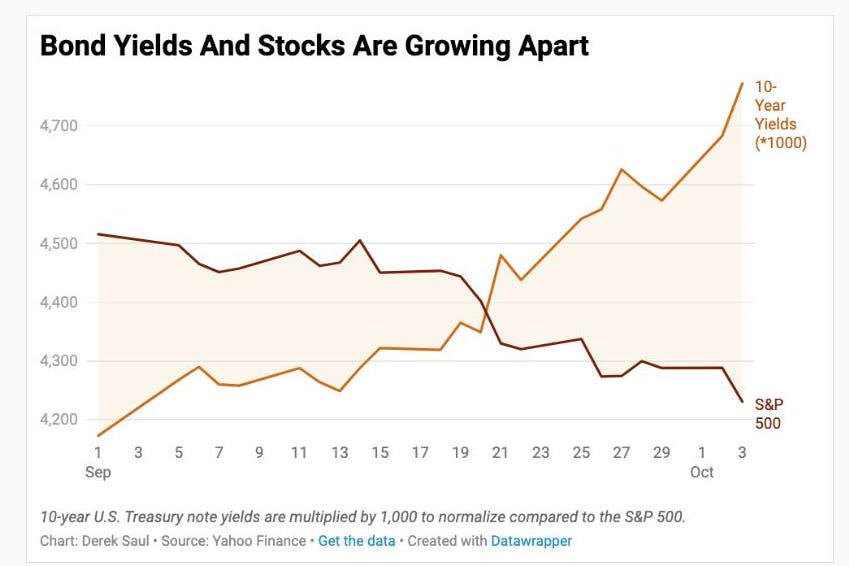Topline
Stocks tanked Tuesday while bond yields soared, again highlighting worries about what high interest rates mean for equities as the Dow and S&P are each on track to notch their lowest close in more than four months.
Key Facts
Higher rates are associated with declines in equity markets, since they cause existing bonds to lose value as other fixed-income securities, such as government-issued bonds, grow more attractive.
Stocks suffer as higher borrowing costs weigh on public companies’ profits, and dividend payouts similarly become less attractive compared to other fixed-income investments.
Over the last month, the relationship between yields and stocks has been especially evident, as the S&P is down 6% while 10-year yields are up more than 60 basis points (rising yields indicate a deterioration of the bond market as already-owned securities lose value on the secondary market).
The decline in both equity classes came as the Fed indicated it will keep rates higher for longer, subsequently sending yields for 10-year and 30-year U.S. Treasury notes to their highest respective levels since 2007 due to increased concerns about higher rates’ effects on stocks and the broader economy.
News Peg
Tuesday was another brutal trading session for stocks. The Dow Jones Industrial Average fell 1%, or 330 points, by 1 p.m. EDT, while the S&P 500 and tech-heavy Nasdaq slid 1.1% and 1.4%, respectively. Specifically driving Tuesday’s spike in rate anxiety was a job openings report which revealed the labor market remains stronger than expected, threatening to encourage the Federal Reserve to further raise rates to keep the economy in check, though Friday’s broader jobs report will reveal the extent to which the labor market kept its luster this summer. The latest jobs data was “not good news” for stocks or bonds as the odds of a rate hike rose, according to Bolvin Wealth Management president Gina Bolvin.
Surprising Fact
The S&P has suffered three of its ten worst daily losses of the year over the last two weeks.
Key Background
The current tightening cycle began early last year as the Fed moved to rein in inflation, bumping the target federal funds rate from near-zero to 5.25% to 5.5% over the course of just 18 months. Equities took a major hit last year as the macroeconomic backdrop grew less friendly to growth, and the S&P tanked 19% while 10-year yields more than doubled. But optimism about the Fed’s ability to stick a “soft landing” where it cools inflation while keeping the economy afloat prevailed for much of 2023, keeping equity investors happy, before September reinvigorated investor uneasiness, triggering losses.
Read the full article here













Leave a Reply